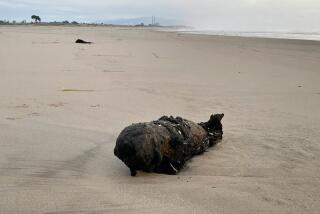Lost Bomb, Lost Credibility
- Share via
On Dec. 5, 1965, an A-4E Skyhawk jet rolled off an elevator platform on the aircraft carrier Ticonderoga and plunged into the Pacific Ocean. The plane and its pilot were lost in waters more than three miles deep. So was a one-megaton hydrogen bomb, a weapon 70 times more powerful than the nuclear device that had been dropped on Hiroshima 20 years earlier.
The incident was kept secret. Not until 1981 did the Navy acknowledge that it had lost a nuclear weapon, saying without identifying the site of the accident that it had occurred “more than 500 miles from land.” In fact, as the Ticonderoga’s records show, the ship was only 70 miles from the nearest island and about 200 miles east of Okinawa, which has a population of more than 1 million and which was then under U.S. administration. It has since reverted to Japan, although it remains the site of major U.S. military facilities.
Only now, thanks to research done by two authors for a book about nuclear accidents at sea, has the truth about the H-bomb loss emerged. The bomb, so defense officials have said, did not at the time of its loss nor does it now present a nuclear hazard. The Navy says it was not armed, a process that requires a complex and carefully controlled set of actions, and so it could not explode. The enormous pressure that occurs at 16,000 feet below sea level has undoubtedly degraded the weapon. Presumably it could release some nuclear pollutants as its falls apart, but without producing serious environmental problems.
Saying this, the fact remains that as long as 16 years after the accident the Navy still was trying to mislead Congress and the public about what took place. It lied--a gentler word would be inappropriate--about the proximity of the accident to land. (A U.S. military spokesman in Tokyo now implausibly suggests that the Navy meant it happened 500 miles from the “Asian mainland.”) Its reason for this deception is readily inferred. The Ticonderoga was bound for a port in Japan, which bars all nuclear weapons from its territory. But by tacit agreement Japan doesn’t ask if U.S. warships entering its waters carry such weapons, and the United States doesn’t volunteer that information.
Revelation of the Ticonderoga accident 24 years ago has now provoked fresh political controversy in Japan. The timing, as it happens, couldn’t be more inconvenient, given the political confrontation that may be looming over the Bush Administration’s recent threats to take stern measures over disputed Japanese trade policies.
What the H-bomb story further reveals is that U.S. carriers participating in the Vietnam war, like the Ticonderoga, kept some of their planes armed with nuclear weapons. That practice, said to be part of the constant nuclear airborne alert practiced for many years by the Air Force and Navy, apparently was halted in 1968. The question that remains is whether before or after the Ticonderoga incident other nuclear weapons may have been lost beyond hope of recovery in the world’s oceans, their loss and their locations unreported and still unknown outside the Pentagon. The question is one that demands an answer, but this time an answer supported by documentation so that it doesn’t depend only on the say-so of Navy officials whose credibility, as the 1981 statement shows, must be regarded as suspect.
More to Read
Sign up for Essential California
The most important California stories and recommendations in your inbox every morning.
You may occasionally receive promotional content from the Los Angeles Times.













